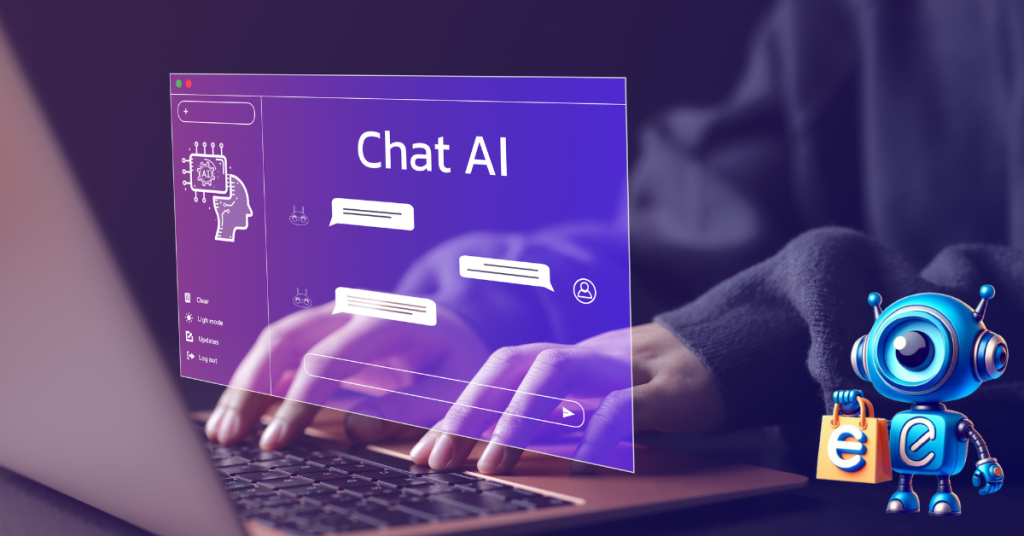AI chatbots are booming today, and this is just the beginning. The future of the two solutions shines bright as the art of customer service becomes increasingly vital. According to a Gartner study, the search engine volume will drop by 25% by 2026 due to AI chatbots and other virtual assistants.
We can already feel the heat as nowadays, there’s a bot for just about everything. With the evolution of technology, companies are in a mad race to create the following best tool or platform.
This guide will answer all your questions before implementing AI chatbots and live chat.
AI Chatbots and Live Chat
An AI chatbot is a piece of software that is designed to interact with humans in written language. A chatbot is usually installed on web pages and other digital platforms to respond to visitors’/clients’ queries without needing human customer representatives. Therefore, Chatbot offers effortless and affordable customer service.
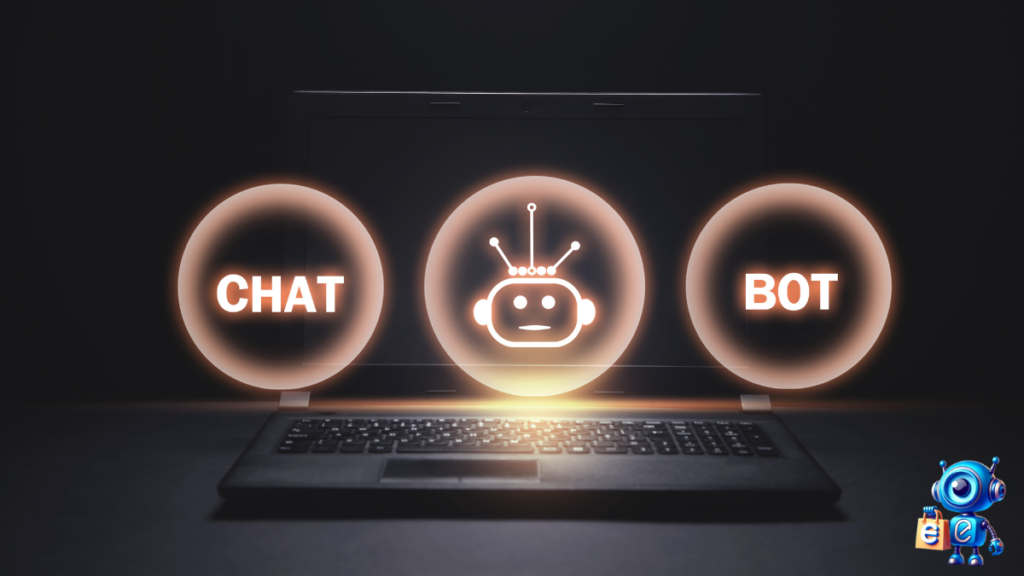
On the other hand, live chat is software that connects clients directly to human representatives on websites or social media platforms. A live chat is added as a plugin or implemented through a code.
It serves as a great alternative to phone calls and emails. Visitors must type their queries or concerns into a chatbox and submit them. You can use the live chat feature to send visitors proactive messages to boost engagement and recreate the in-store experience virtually.
Types of AI Chatbots
Chatbots come in various types, and it’s essential to familiarize yourself with them to determine which one to choose and reap all of their benefits.
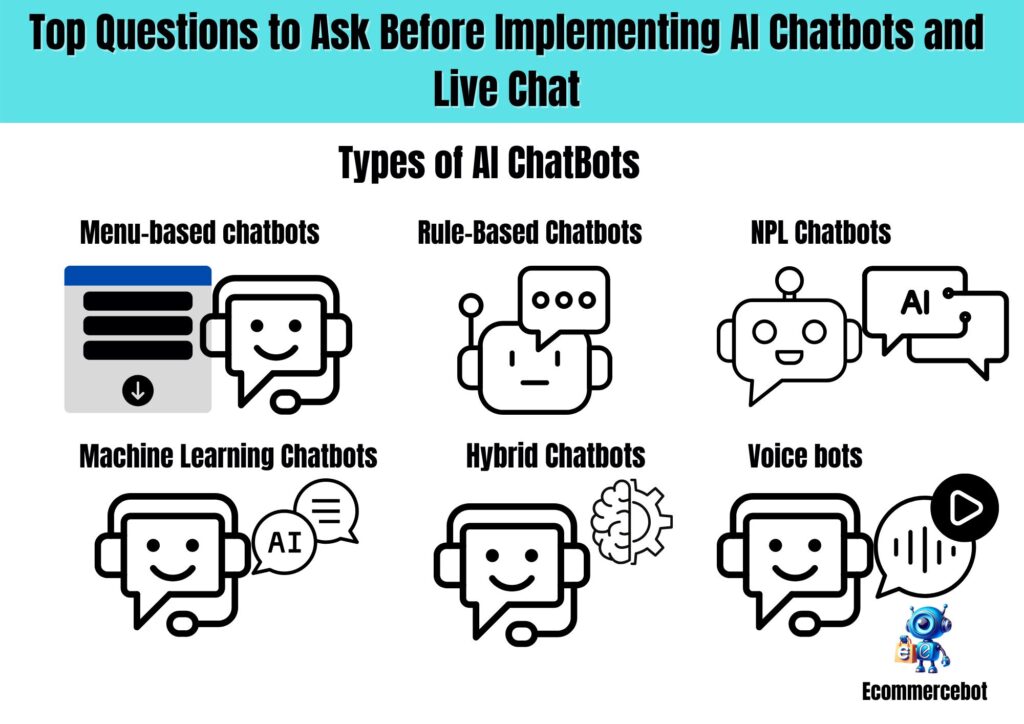
1. Menu-based chatbots
They are also known as button-based chatbots or decision trees because they use the decision tree type of logic.
Menu-based chatbots are the most common types and are displayed to users as menu buttons. The user then picks the option that aligns with their questions or inquiry to find answers. These chatbots answer mainly FAQs and may need to be more for complex queries.
2. Rule-Based Chatbots
These types of chatbots are also called linguistic or keyword recognition-based chatbots. They are usually used by businesses that know the kind of customer queries they receive.
The linguistic bots use the if-then logic to help them create conversational automation flows. The logic involves adding specific words that trigger certain types of particular answers.
The bot can provide the appropriate answer when a customer uses a word or words available within the list of established language parameters.
3. NPL Chatbots
These chatbots use Natural language programming technology to help them understand human language. This bot understands the entire context of the users’ intention. Unlike rule-based chatbots, NPL chatbots better understand more specific user queries and provide appropriate and particular responses.
4. Machine Learning Chatbots
They are also known as contextual chatbots. These types are the more advanced versions.
They use machine learning and AI technologies to memorize their conversations with users. As a result, they can learn and develop over time.
The ML chatbots save past information such as billing, shipping, etc. The next time a user wants to place an order, the contextual Chatbot asks them if they wish to employ the same preferences currently saved in its database.
ML chatbots hold the potential for plenty of personalization to help your customers feel valued.
5. Hybrid Chatbots
These chatbots combine AI with rule-based technologies to offer the most appropriate assistance to users. Hybrid chatbots allow users to use chatbots and live chat simultaneously.
The bot can answer basic questions up to the point where more complex ones arise. The bot can then escalate the complex issue to the support team without disrupting the flow of the conversations.
6. Voice bots
These chatbots are conversational AI or virtual assistants that use speech-to-text and text-to-speech functions. They also use AI and natural language (NLU) to understand users’ questions.
Users don’t need to type anything; they ask questions loudly on their mobile phones or computers. The audio is then converted into text to help the bot analyze the human intent and provide answers via text-to-speech. The user then instantly receives answers by voice.
Key Features of AI Chatbots
For Chatbots to deliver exceptional customer service, they are equipped with various advanced vital features, including:
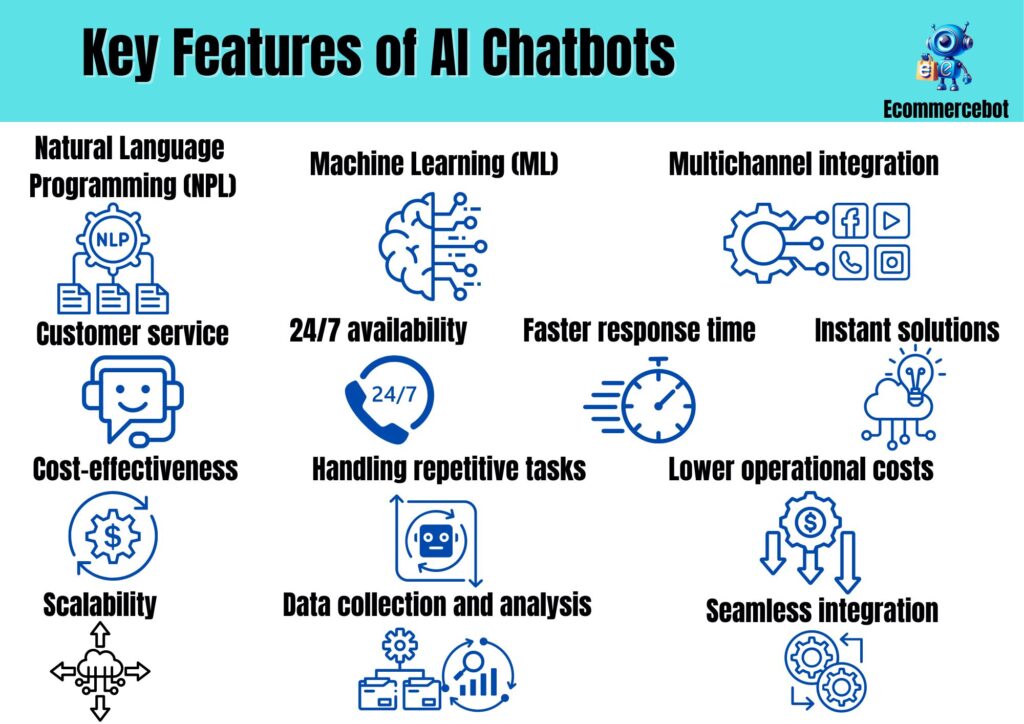
- Natural Language Programming (NPL) – This feature helps chatbots understand and interpret human language and interact with users naturally and meaningfully.
- Machine Learning (ML) – ML algorithm helps chatbots improve their responses based on past interactions to provide more specific responses over time.
- Multichannel integration – Chatbots can integrate with multiple channels, including websites, social media platforms, etc, to provide consistent support across all the channels.
- Customer service – Chatbots enhance customer service in various ways, including:
- 24/7 availability
- Faster response time
- Instant solutions
- Cost-effectiveness – Chatbots offer cost-saving benefits such as:
- Handling repetitive tasks
- Lower operational costs
- Scalability
- Data collection and analysis – Chatbots are also practical data collection tools that can gather customer feedback and analyze interactions to improve the quality of service
- Seamless integration with the existing system – Through seamless integration with the existing systems, chatbots access customer data, providing a more personalized experience.
Benefits of AI-powered chatbots
Chatbots offer many benefits for both the customers and the business. These benefits include:
1. Increase customer engagement
Chatbots can improve customer engagement by delivering clear and concise responses through data-driven insights. Customers tend to spend more time in the business app when they receive relevant responses.
2. Lead generation
There are various ways that chatbots help to improve lead generation. They include:
- 24/7 service – Lead generation opportunities are available round the clock.
- Gather contact information – Chatbot gathers customers’ contact information, making gathering lead information more accessible for both the prospects and the sales team.
- Automation of sales conversion – By automating the sales funnel, Chatbots allow prequalification of leads based on asking specific questions, i.e., they can direct clients to the right sales team.
3. Lower Customer service costs
Customer service chatbot implementation can help reduce the extra cost that can be used to hire extra staff. A business can do the following through AI chatbots:
- Automate its processes
- Re-shape customer service models for communication efficiency
- Scale chat support for new releases or during peak hours
- Agent efficiency
4. Monitor customer information to gain insights
Chatbots also understand customers’ buying habits using data from the company’s databases to generate a response.
They can respond with relevant information by using this data to study customer behavior. Businesses can use this data to increase reach and market their products more successfully.
Benefits of AI-powered Chatbots to a customer
Enhanced Accessibility
Thanks to the increased support bandwidth, customer queries won’t have to wait for the next available agent to be answered. Chatbots can operate outside regular business hours, so customers can interact with them whenever it’s most convenient.,
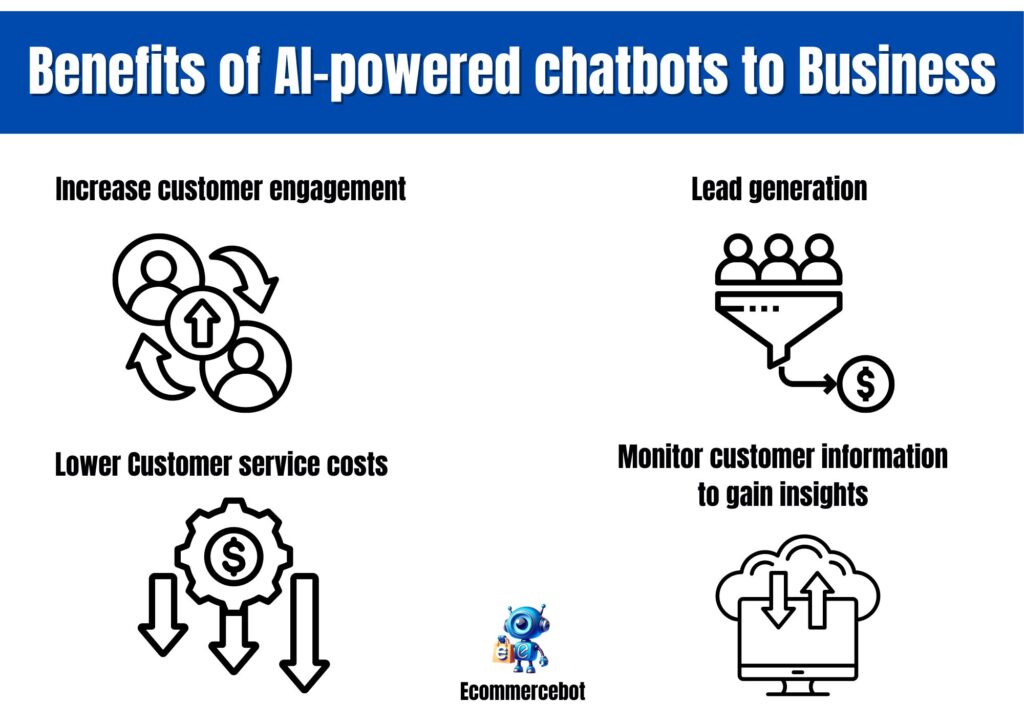
Multichannel Communications
Reach out to your clients where they are! Chatbots can be programmed to respond to clients’ inquiries across many platforms. This helps companies use various channels like websites, social media, and messaging services.
Multilingual
Multilingual chatbots can respond to queries in more than one language. The customer can feel free to ask any queries they may have because they can respond to them in the language of their choice.
Consistency in responses
A chatbot can maintain strong customer relationships by providing concise and relevant responses.
By providing personalized and appropriate responses to queries, Customer experience can be significantly enhanced, and long-lasting relationships can be formed.
How Ecommercebot.com Integrates AI Chatbots

Omnichannel Support: Handling Customer Queries 24/7
Ecommercebot Omnichannel chatbot is the best Chatbot for ecommerce businesses today. The AI-powered Chatbot offers live chat support to customers all around the clock. This ensures that all queries are answered anytime across all social media platforms.
The Omnichannel chatbot uses Natural language processing and Machine learning algorithms to understand queries and provide relevant responses. The AI-powered Chatbot can be prompted to hand over to a live agent without interfering with the chat history.
It can handle large volumes of customer queries and inquiries, allowing the human customer representatives time to focus on other issues that require human attention.
Integration with Shopify for Inventory Management
Ecommercebot.com integrates with Shopify through the Shopifybot to offer online store owners an opportunity to enjoy real-time inventory and order tracking for live chat. It provides detailed insights to help business owners make informed decisions and stay in control.
The ShopifyBot and its integration into the Shopify store will unleash growth for your business. Its real-time radar updates you on what’s flying off the shelves and what needs restocking through instant notifications. Customers can quickly check the status of their orders through the Chatbot, eliminating the need for manual monitoring and increasing customer satisfaction.
Accuracy and Efficiency: 99% Accuracy Rate
The ecommercebot.com AI live chat offers real-time customer interactions while handling 95% of their queries. It can solve customers’ requests with 99% accuracy compared to live chats. The ecommercebot AI chatbots escalate complex queries to human agents when needed. This “human handoff” feature ensures all inquiries that require human intervention can be addressed by a natural person while AI efficiently handles the rest.
EcommerceBot.com goes beyond just chatbots. The platform builds robust cloud infrastructure to meet your specific needs. On top of that, they offer solutions that deliver unmatched speed, surpassing even popular LiveChat platforms.
How to Implement AI Chatbots on Your Website
To learn how to implement AI chatbots on your Website, use the following simple steps:
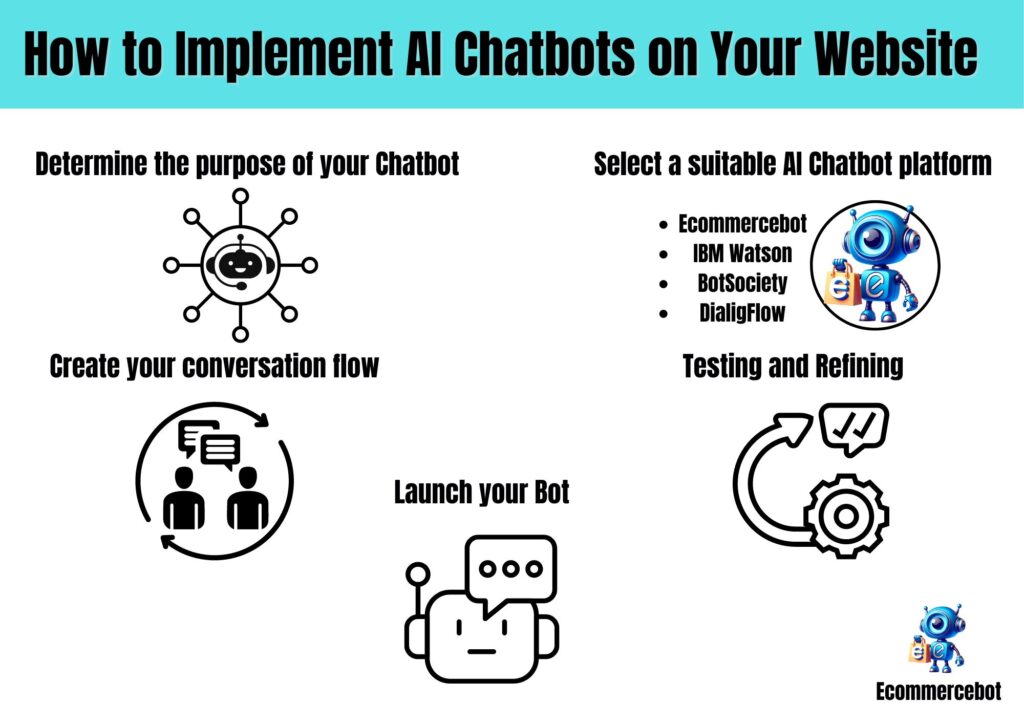
1. Determine the purpose of your Chatbot
The first step in implementing a chatbot is to define its purpose.
You’ll need to consider various factors, including using the Chatbot on your Website, the target audience, the problems you want it to solve, and the integrations it should seamlessly connect with.
Having a clear end goal in mind helps you narrow down a provider. It’s important to note that a chatbot is not an accessory but a part of your team, so you need to plan its role to help with the design and writing process.
2. Select a suitable AI Chatbot platform
You’ll meet many platforms and programming languages that create chatbots, including IBM Watson, BotSociety, and DialigFlow. However, using a reliable live chat platform like ecommercebot.com is recommended. This platform has a built-in AI chatbot for easy management, monitoring, and handovers. Ecommercebot offers a combination of AI automation, live chat, and customer messaging. Regardless of the platform your customers use to reach out to you, ecommercebot.com manages the AI chatbot and the live agents from the same dashboard, allowing you to answer and organize chats from all channels.
3. Create your conversation flow
It’s essential to design a helpful chatbot conversation flow so that you can come up with multiple intents and keep your answers concise.
Creating different intents, regardless of having similar answers, helps strengthen the AI chatbot’s contextual understanding. This reduces the chances of the Chatbot returning to the agents when specific questions arise.
The Chatbot increases its knowledge base and improves accuracy the more it interacts with your customers. This translates to faster resolution, satisfied customers, and reduced workload for your agents.
4. Testing and Refining
Once you are through with building, you need to test the AI Chabot from a user’s perspective. You can do a soft launch of the Chatbot and let your colleagues or employees try it out.
In most cases, Chatbots are added the same way you add live agents. Customize the AI Chatbot, set the dashboard parameters accordingly, and go live. Do all kinds of checks, including:
- Whether links and redirects are working
- The clarity of images and other media
- The clarity of answers
- Is it easy to hand over issues to an agent?
5. Launch your Bot
Once you confirm that everything is set and the Chatbot has passed the testing stage, it’s time to launch it.
Direct it to the pages that make the most sense for its purpose during its launch. For instance, if your Chatbot aims to generate more leads and sales, launch it for sitewide use.
If its purpose is mainly customer support, it makes sense to include it on the contact page of your Website and in popular, well-known messaging services like WhatsApp.
Boost the AI chatbot’s visibility by promoting it to your social media pages. Your target audience will notice and start using it in no time.
Read Also:
- Shopify Bots To Try Right Now For Ecommerce Store
- The Guide To Ecommerce Bots: Different Types And Examples
- Ecommercebot vs Tidio: Which Chatbot Works Best
- Ecommercebot vs Manychat: How Do They Differ
- 8 Myths About AI In Ecommerce: Fact From Fiction
Best Practices for Using AI Chatbots
Business owners aim for seamless interactions between the AI chatbots and their customers. To achieve this, you must familiarize yourself with the key elements that make these interactions effective.
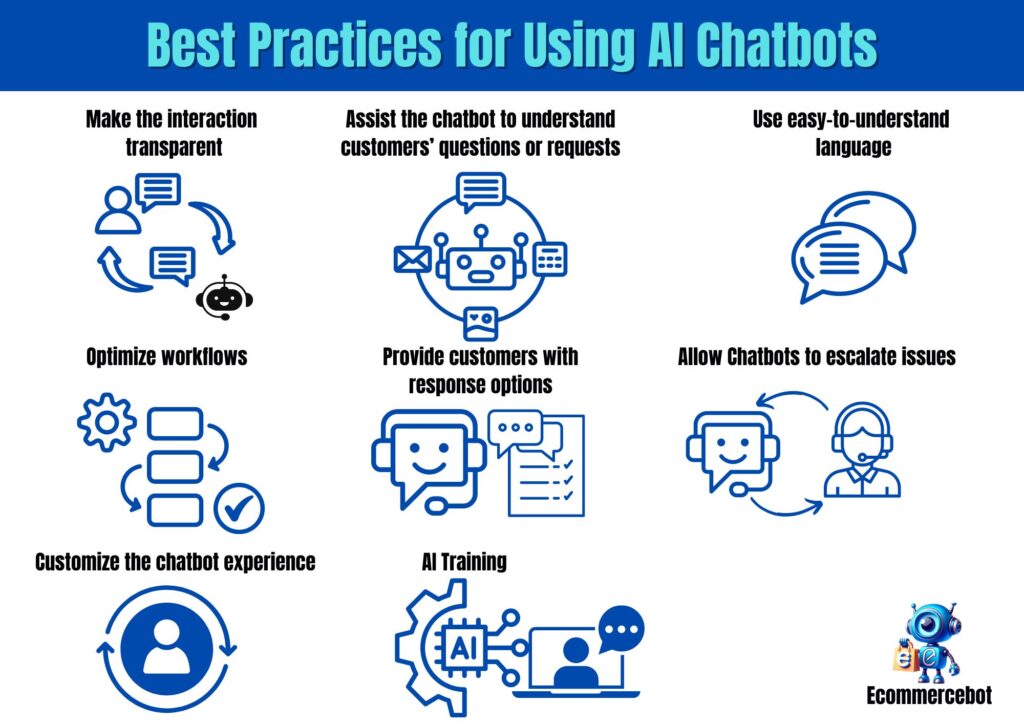
The following are the best practices for using AI Chatbots:
1. Make the interaction transparent
You must be honest that the customers engage with a chatbot to build trust. This should be done at the start of the interaction. Be clear and open about the expectations to create an environment of honesty to prevent frustration or dissatisfaction from the inapplicable expectations.
2. Assist the Chatbot to understand customers’ questions or requests
The performance of a chatbot is measured by its ability to understand what a customer is looking for. To equip your Chatbot with the appropriate knowledge, you must analyze and study common support questions and customer-agent interactions. This will help your Chatbot answer the customers’ queries effectively.
3. Optimize workflows
Efficiency is vital in customer service, and chatbots help optimize workflows. Establishing workflows that speed up problem-solving guarantees that consumers can resolve their issues quickly, increasing customer happiness and loyalty.
4. Provide customers with response options
Providing customers with suggested responses is also a critical best practice. Customers can click on pre-defined answers, enhancing user engagement and control over the interaction. It guides the conversation in the right direction, making the interaction efficient and fulfilling.
5. Use easy-to-understand language
Create clear and easy-to-understand Chatbot responses using simple conversational language. Avoid using complex vocabulary and complicated terms that can confuse the user. Make interactions seamless and enjoyable using friendly and straightforward language.
6. Allow Chatbots to escalate issues
An AI chatbot can be 99% effective, but there are situations in which they can’t answer customers’ questions adequately. For this reason, allow the Chatbot to escalate complex issues to live agents for smooth interactions. Having humans assist AI chatbots ensures no unresolved queries, improving customer satisfaction.
7. Customize the chatbot experience
You can begin the conversations with greetings by name to enhance the chatbot user experience. Also, let your AI Chatbot provide relevant content or offers and maintain the conversation context to create an engaging user experience.
8. AI Training
To boost the accuracy of the AI chatbot, consider training the AI model. Training helps the Chatbot learn from previous interactions and offer more reliable and accurate responses in the future.
Future Trends in AI Chatbots
Chatbots play a significant role in improving performance and efficiency in many areas. In this section, we have highlighted some key statistics to show the journey to the future of AI chatbots:
Efficiency in operations
Statistics show that 80% of e-commerce users regard bots to be beneficial. Additionally, 77% of consumers think chatbots can positively change their life. This is excellent news for companies and the industry as a whole. It demonstrates the improved and promising future of e-commerce bots.
Global Reach and Adoption Rate
The top 5 countries with the most potential, namely the US, UK, Germany, India, and Brazil, use e-commerce bots. By 2027, chatbots, which are constantly evolving, will be the primary means of customer support for all businesses worldwide.
Accessibility 24/7
Statistics indicate that 62% of consumers prefer using chatbots over human operators because they are instantaneously available. This is a positive statistic that suggests a lot of businesses will want chatbots to be instantly available for their business as e-commerce develops.
Future Dominance and Revenue Growth
Almost all companies use chatbots nowadays, no matter how big or small. Their potential domination is evident from the efficient solutions they provide.
Businesses receive higher revenue due to the growing demand for chatbots. Companies can reduce their customer service expenses by up to 30%, which, on the other hand, boosts income.
Unlock unprecedented growth in just 30 days with our comprehensive, results-driven strategy. Our 30 Days Growth Guarantee Plan is designed to supercharge your ecommerce business with tailored solutions that cover all critical aspects of digital marketing and automation.

